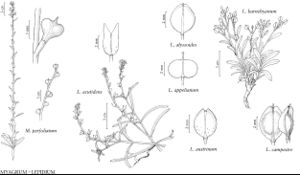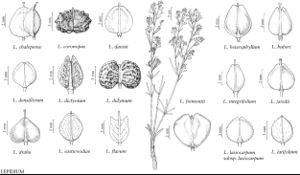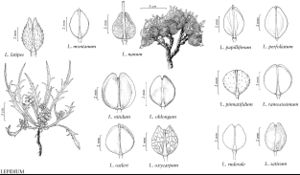Lepidium
Sp. Pl. 2: 643. 1753.
Gen. Pl. ed. 5, 291. 1754.
Plants not scapose; glabrous, pubescent, hirsute, or pilose. Stems usually erect or ascending, sometimes procumbent, decumbent, or prostrate, unbranched or branched. Leaves usually basal and cauline (basal absent in L. fremontii); petiolate or sessile; basal rosulate or not, petiolate (or petiole undifferentiated from blade), blade margins entire, dentate, denticulate, serrate, crenate, or lobed; cauline petiolate or sessile, blade (base auriculate or not), margins entire, dentate, or pinnately divided. Racemes (usually corymbose), elongated or not in fruit. Fruiting pedicels erect to divaricate, slender or stout. Flowers: sepals (usually deciduous, sometimes persistent), usually ovate or oblong, rarely suborbicular; petals (erect or spreading, sometimes rudimentary or absent), obovate, spatulate, oblong, oblanceolate, orbicular, linear, or filiform, claw absent or differentiated from blade, (apex obtuse, rounded, or emarginate); stamens 2 or 4 and equal in length, lateral or median, or 6 and tetradynamous; filaments not dilated basally; anthers ovate or oblong; (ovary placentation apical); nectar glands (4 or 6), distinct, median glands often present. Fruits schizocarps or silicles, (rarely indehiscent), sessile, didymous, oblong, ovate, obovate, cordate, obcordate, elliptic, orbicular, ovoid, obovoid, or globose, strongly angustiseptate or inflated and terete; valves each with prominent veins or not veined, (keeled or rounded, apex winged or not, thin or strongly thickened and ornamented, enclosing or readily releasing seed), glabrous or pubescent; replum rounded, (visible); septum complete or perforated; style absent, obsolete, or distinct, (included or exserted from apical notch); stigma capitate, usually entire, rarely 2-lobed. Seeds oblong or ovate [obovate], plump or flattened, winged, margined, or not winged; seed-coat (smooth, minutely reticulate, or papillate), usually copiously mucilaginous when wetted, rarely not; cotyledons usually incumbent (accumbent in L. virginicum) [diplecolobal].
Distribution
North America, Mexico, Central America, South America, Europe, Asia, n, s Africa, Australia
Discussion
Species ca. 220 (42 in the flora).
The limits of Lepidium were expanded by I. A. Al-Shehbaz et al. (2002) to include Cardaria, Coronopus, and Stroganowia. Molecular data (J. L. Bowman et al. 1999; K. Mummenhoff et al. 2001) provide overwhelming support for this circumscription. A. Thellung (1906) was the first to take such a position, but subsequent authors largely ignored his work. Indeed, three Linnaean species, originally described as L. chalepense, L. didymum, and L. draba, were the core of the genera Cardaria and Coronopus. Both are nested within Lepidium, and Coronopus was clearly shown to be polyphyletic (C. D. Bailey et al. 2007). All three taxa differ from Lepidium by trivial fruit characters; the interested reader should consult Al-Shehbaz et al. for discussions.
Lepidium species are reasonably well-defined worldwide, and taxonomists often find no problems in telling them apart. The infraspecific taxonomy, especially some of the North American species, is in a state of disarray. The main reason is dependence on characters of questionable value to establish most varieties. For example, glabrous and pubescent forms were almost always recognized as distinct varieties despite the fact that they occur within the same population. The painstaking work of R. C. Rollins (1958) on Dithyrea clearly demonstrated that the presence versus absence of trichomes can result from a minor genetic difference. Rollins (1993) and others (e.g., N. H. Holmgren 2005b) were influenced by the excellent work of C. L. Hitchcock (1936, 1945, 1950), who then had no idea about the genetic basis of such differences. A similar situation exists in Draba, where tens of varieties were established based on glabrous versus pubescent fruits. In this account, we do not recognize such varieties, and the interested reader is referred to the discussion under 35. L. ramosissimum.
Due to their release of copious mucilage upon wetting, the seeds of most species of Lepidium can be transported easily by animals, especially migratory birds, for long distances. This most likely accounts for the transcontinental dispersals in the genus discussed by K. Mummenhoff et al. (2001).
Lepidium africanum (Burman f.) de Candolle, L. bonariense Linnaeus, L. graminifolium Linnaeus, and L. schinzii Thellung have been recorded from North America as ballast introductions (I. A. Al-Shehbaz 1986b; R. C. Rollins 1993). Apparently, they never became naturalized in the flora area and, therefore, are not included in this account. For a recent report of L. bonariense, see the discussion under 28. L. oblongum.
Selected References
Lower Taxa
Key
| 1 | Cauline leaves (at least some) sessile, blade bases auriculate, sagittate, or amplexicaul | > 2 |
| 1 | Cauline leaves usually petiolate, blade bases (when sessile) not auriculate, sagittate, or amplexicaul (absent in L. nanum) | > 8 |
| 2 | Plants glabrous or sparsely pubescent proximally; uppermost cauline leaf blades: bases cordate-amplexicaul; basal leaf blades: margins 2- or 3-pinnatifid or pinnatisect; petals yellow. | Lepidium perfoliatum |
| 2 | Plants usually puberulent or hirsute proximally, rarely glabrate; uppermost cauline leaf blades: bases auriculate or sagittate; basal leaf blades: margins usually entire, subentire, dentate, denticulate, lyrate, or sinuate, rarely 1- or 2-pinnatifid; petals (when present) white | > 3 |
| 3 | Stamens 2; petals absent or rudimentary; basal leaf blades: margins 1- or 2-pinnatifid; styles usually obsolete (rarely to 0.1 mm). | Lepidium oblongum |
| 3 | Stamens 6; petals present (distinct); basal leaf blades: margins usually entire, subentire, dentate, denticulate, lyrate, or sinuate, rarely pinnatifid; styles distinct (0.2 mm or longer) | > 4 |
| 4 | Plants not rhizomatous; fruits dehiscent, apically broadly winged, notch present; racemes much-elongated in fruit | > 5 |
| 4 | Plants rhizomatous; fruits indehiscent, apically not winged, notch absent; racemes not much-elongated (corymbose panicles) in fruit | > 6 |
| 5 | Annuals; fruit valves papillate; styles 0.2-0.5(-0.7) mm, included or only slightly exserted beyond apical notch of fruits. | Lepidium campestre |
| 5 | Perennials (with caudex); fruit valves often not papillate; styles (0.6-)1-1.5 mm, well-exserted beyond apical notch of fruits. | Lepidium heterophyllum |
| 6 | Fruits flattened, cordate to subreniform, valves reticulate-veined. | Lepidium draba |
| 6 | Fruits inflated, globose, subglobose, obovoid, or obcompressed globose, valves not reticulate-veined | > 7 |
| 7 | Fruits usually globose, rarely subglobose, (2-)3-4.4(-5) mm wide, valves puberulent; styles 0.5-1.5 mm. | Lepidium appelianum |
| 7 | Fruits obovoid to subglobose, or obcompressed globose, (3.5-) 4-6.2(-7) mm wide, valves glabrous; styles (0.8-)1.2-2(-2.3) mm. | Lepidium chalepense |
| 8 | Valves rugose or rugose-verrucose | > 9 |
| 8 | Valves usually smooth (rarely minutely papillate in L. jaredii) | > 10 |
| 9 | Fruits reniform to ovate-cordate, 2.3-3.4 mm, apical notches absent, ridged; stamens 6. | Lepidium coronopus |
| 9 | Fruits didymous, 1.3-1.7 mm, apical notches present, not ridged; stamens 2. | Lepidium didymum |
| 10 | Subshrubs or perennials (caudex woody, sometimes with persistent petiolar remains) | > 11 |
| 10 | Annuals or biennials (without woody caudex, without persistent petiolar remains) | > 24 |
| 11 | Styles included in apical notch of fruits; stamens 2; petals absent or rudimentary. | Lepidium paysonii |
| 11 | Styles usually exserted beyond apical notch of fruits, rarely subequaling notch, or notch absent; stamens 6 (or 2 or 4 in L. integrifolium); petals well-developed | > 12 |
| 12 | Basal and proximalmost cauline leaf blade margins pinnately lobed | > 13 |
| 12 | Basal and proximalmost cauline leaf blade margins usually entire, crenate, or dentate, rarely palmately 3-5-lobed (at apex) | > 17 |
| 13 | Plants glabrous throughout; basal leaves absent; fruits 4.2-7(-8) mm wide. | Lepidium fremontii |
| 13 | Plants puberulent (at least on fruiting pedicels or rachises); basal leaves present; fruits (1.5-)1.8-3.6(-4) mm wide | > 14 |
| 14 | Fruits broadly obovate; fruiting pedicels puberulent throughout. | Lepidium huberi |
| 14 | Fruits ovate to suborbicular or oblong; fruiting pedicels puberulent adaxially, rarely glabrous | > 15 |
| 15 | Fruits usually ovate to suborbicular, rarely oblong; basal leaf blades: margins 1- or 2-pinnatifid to -pinnatisect; cauline leaf blades: margins often pinnately lobed. | Lepidium montanum |
| 15 | Fruits broadly ovate; basal leaf blades: margins pinnately lobed; cauline leaf blades: margins usually entire, rarely dentate | > 16 |
| 16 | Perennials or subshrubs; stems (0.7-)1-4.8(-6.1) dm; middle cauline leaf blades (0.7-)1-2(-3) mm wide. | Lepidium alyssoides |
| 16 | Perennials; stems (3.5-)4.5-16(-18) dm; middle cauline leaf blades (2.5-)4-10 mm wide. | Lepidium eastwoodiae |
| 17 | Plants pulvinate or cespitose; basal leaf blades: margins usually subapically or apically 3-5-toothed or -lobed, rarely entire (L. barnebyanum); fruiting pedicels puberulent throughout | > 18 |
| 17 | Plants not pulvinate, not cespitose; basal leaf blades: margins entire or uniformly dentate; fruiting pedicels usually puberulent adaxially, rarely glabrous | > 21 |
| 18 | Basal leaves rosulate; cauline leaves absent; anthers 1.4-2 mm. | Lepidium nanum |
| 18 | Basal leaves not rosulate; cauline leaves present; anthers 0.3-0.8 mm | > 19 |
| 19 | Basal leaf blades: margins entire; petals 3.2-4.6 mm; fruits 4-5.5(-6.2) mm. | Lepidium barnebyanum |
| 19 | Basal leaf blades: margins subapically 3-5-lobed or toothed, rarely entire (L. davisii); petals 2-3.5 (-4) mm; fruits 2.5-4(-5) mm | > 20 |
| 20 | Plants cespitose; fruits suborbicular to broadly ovate; styles 0.5-1 mm; seeds (1.8-)2-2.3 mm. | Lepidium davisii |
| 20 | Plants pulvinate; fruits ovate; styles 0.3-0.6 mm; seeds 1.2-1.5 mm. | Lepidium ostleri |
| 21 | Fruits obovate to somewhat rhomboid, 7-11 mm; fruiting pedicels glabrous; seeds 3.7-4.5 mm. | Lepidium tiehmii |
| 21 | Fruits oblong-elliptic, ovate, oblong, or suborbicular, 1.6-4(-4.4) mm; fruiting pedicels usually pubescent or puberulent, sometimes glabrous (less than 6 mm); seeds 0.8-2 mm | > 22 |
| 22 | Plants rhizomatous; fruits (1.6-)1.8-2.4(-2.7) mm, apically not winged, notch usually absent; styles 0.05-0.15 mm. | Lepidium latifolium |
| 22 | Plants not rhizomatous; fruits (2.5-)3-4(-4.4) mm, apically winged, notch present; styles 0.2-1 mm | > 23 |
| 23 | Perennials or subshrubs (woody base aboveground); stamens 6; racemes slightly elongated (subcorymbose panicles) in fruit. | Lepidium crenatum |
| 23 | Perennials (woody base not aboveground); stamens usually 4, rarely 2 or 6; racemes elongated (not corymbose) in fruit. | Lepidium integrifolium |
| 24 | Stamens 2 | > 25 |
| 24 | Stamens 4 or 6 | > 33 |
| 25 | Fruit valves distinctly reticulate-veined; sepals persistent. | Lepidium strictum |
| 25 | Fruit valves usually not veined (rarely weakly veined); sepals deciduous or, rarely, tardily so | > 26 |
| 26 | Fruits 1.7-2.1 × 1.2-1.6 mm; plants puberulent with clavate trichomes. | Lepidium sordidum |
| 26 | Fruits 1.8-7 × 1.5-5(-5.6) mm; plants puberulent, hirsute, or hispid with cylindrical trichomes | > 27 |
| 27 | Fruiting pedicels often strongly flattened, 0.2-0.7 mm wide; fruit valves hirsute to hispid (sometimes only on margins). | Lepidium lasiocarpum |
| 27 | Fruiting pedicels terete or only slightly flattened, 0.1-0.3(-4) mm wide; fruit valves glabrous or puberulent (at least on margins) | > 28 |
| 28 | Fruits elliptic | > 29 |
| 28 | Fruits obovate, suborbicular, or orbicular | > 30 |
| 29 | Basal leaf blades pinnatifid; racemes slightly elongated in fruit, rachises with curved trichomes; fruiting pedicels usually puberulent adaxially, rarely throughout. | Lepidium ramosissimum |
| 29 | Basal leaf blades (1- or) 2- or 3-pinnatisect; racemes considerably elongated in fruit, rachises with straight trichomes; fruiting pedicels puberulent throughout. | Lepidium ruderale |
| 30 | Plants hirsute; basal leaf blade margins pinnatifid | > 31 |
| 30 | Plants puberulent or glabrous; basal leaf blade margins dentate, serrate, lyrate, or pinnatifid | > 32 |
| 31 | Stems often simple from base; rachises pubescent, trichomes curved with fewer, longer, straight ones. | Lepidium austrinum |
| 31 | Stems often several from base; rachises hirsute, trichomes mostly straight. | Lepidium oblongum |
| 32 | Fruits obovate to obovate-suborbicular, widest beyond middle; rachises with straight, slender to subclavate trichomes; petals absent or rudimentary, 0.3-0.9 mm; cotyledons incumbent. | Lepidium densiflorum |
| 32 | Fruits orbicular, widest at middle; rachises usually with curved, cylindrical trichomes, rarely glabrous; petals usually present, rarely rudimentary, 1-2(-2.5) mm; cotyledons usually accumbent, rarely incumbent. | Lepidium virginicum |
| 33 | Stamens 4; styles usually obsolete, rarely to 0.1 mm, usually included in, or equaling, apical notch of fruits | > 34 |
| 33 | Stamens 6; styles (0.1-)0.2-1.6 mm, usually exserted beyond, rarely subequaling or included in, apical notch of fruits | > 39 |
| 34 | Fruiting pedicels terete or slightly flattened, 0.1-0.3 mm wide | > 35 |
| 34 | Fruiting pedicels strongly flattened, 0.4-1.4 mm wide | > 36 |
| 35 | Fruits 2.4-3.6 mm, apically winged, apical notches 0.3-0.8 mm deep; stamens all median; petals absent. | Lepidium oxycarpum |
| 35 | Fruits 1.8-2 mm, apically not winged, apical notches 0.05-0.1 mm deep; stamens 2 median, 2 lateral; petals present (rudimentary, 0.4-0.6 mm). | Lepidium pinnatifidum |
| 36 | Sepals somewhat persistent; fruit valves hirsute (trichomes spreading, mixed with smaller ones); petals usually pubescent on outside, rarely glabrescent, with fringed margin; racemes compact, subcapitate to cylindrical in fruit. | Lepidium latipes |
| 36 | Sepals deciduous; fruit valves glabrous or (sparsely, uniformly) puberulent, pubescent, or hirsute (sometimes only on margin); petals usually absent, when present, glabrous, without fringed margin; racemes lax or somewhat dense, not compact in fruit | > 37 |
| 37 | Petals usually present, rarely rudimentary or absent; fruit valves slightly veined or not; fruiting pedicels not appressed to rachises. | Lepidium nitidum |
| 37 | Petals absent; fruit valves strongly reticulate-veined; fruiting pedicels appressed to rachises or distally recurved | > 38 |
| 38 | Fruits (3-)4-6 × 2.5-3.5 mm, apical notches (0.8-)1-2 mm deep, V-shaped; fruiting pedicels (2-)3-4.2 mm. | Lepidium acutidens |
| 38 | Fruits 2.5-3.5 × 2-2.8 mm, apical notches 0.5-0.7(-0.8) mm deep (closed), often U-shaped; fruiting pedicels (1.6-)1.9-2.5(-3) mm. | Lepidium dictyotum |
| 39 | Fruiting pedicels suberect to ascending, subappressed to rachises; fruits (4-) 5-6.4(-7) mm; styles usually included in, rarely subequaling, apical notch of fruits; cotyledons 3-lobed. | Lepidium sativum |
| 39 | Fruiting pedicels divaricate-ascending to horizontal or descending, not appressed to rachises; fruits 2-3.8(-4.2) mm; styles exserted from apical notch of fruits; cotyledons entire | > 40 |
| 40 | Petals usually yellow (rarely creamy white at early anthesis, or fading whitish) | > 41 |
| 40 | Petals white | > 42 |
| 41 | Fruiting pedicels (2.7-)3-4.4(-5) mm, glabrous adaxially; racemes dense, slightly elongated (corymbose to subcapitate) in fruit, rachises glabrous adaxially; fruits divergently winged apically, apical notches 0.2-0.6 mm deep. | Lepidium flavum |
| 41 | Fruiting pedicels 5-15 mm, pilose adaxially; racemes lax, much-elongated in fruit, rachises usually pilose, rarely glabrous; fruits not winged apically, apical notches 0(-0.1) mm deep. | Lepidium jaredii |
| 42 | Filaments puberulent. | Lepidium papilliferum |
| 42 | Filaments glabrous | > 43 |
| 43 | Annuals; rachises pilose, trichomes straight. | Lepidium thurberi |
| 43 | Annuals or biennials; rachises puberulent, trichomes straight or curved | > 44 |
| 44 | Petals suborbicular, 1.5-2.5 mm wide; cauline leaf blades lanceolate or oblanceolate to linear; stems (3.5-)4.5-16(-18) dm, often simple from base. | Lepidium eastwoodiae |
| 44 | Petals spatulate to oblanceolate, 1.3-1.8 mm wide; cauline leaf blades often pinnatifid to pinnatisect, sometimes linear; stems 0.4-5(-7) dm, simple or few to several from base. | Lepidium montanum |
"not" is not a number. "elongated" is not a number."thick" is not a number.


